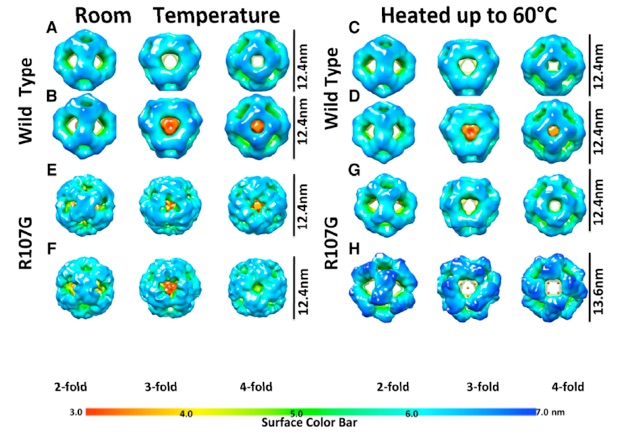Structural insight into a temperature sensitive mutant R107G of small heat shock protein Hsp16.5
(In collaboration with Prof. Roy Quinlan, Durham University, UK)

The archael small heat shock protein, MjHSP16.5 forms a 24-subunit oligomer with octahedral symmetry. Here we demonstrate that the I-X-I motif present in the C-terminal domain is necessary for the oligomerisation of MjHSP16.5. Removal increased the in vitro chaperone activity with citrate synthase as the client protein. Less predictable were the effects of the R107G substitution in MjHSP16.5 because of the differences in the oligomerisation of metazoan and non-metazoan sHSPs. We present the crystal structure for MjHSP16.5 R107G and compare this to an improved (2.5?) crystal structure for wild type MjHSP16.5. Although no significant structural differences were found in the crystal, using cryo-electron microscopy we identified two 24mer species with octahedral symmetry for the wild type MjHSP16.5 both at room temperature and 60°C, all showing two major species with the same diameter 12.4nm. Similarly, at room temperature there are also two kinds of 12.4nm oligomers for R107G MjHSP16.5. but in the 60°C sample, however, a larger 24mer species with the diameter of 13.6nm was observed with significant changes in the 4-fold symmetry axis and dimer-dimer interface. This highly conserved arginine therefore contributes to the quaternary organisation of non-metazoan sHSP oligomers. Potentially the R107G substitution has functional consequences as R107G MjHSP16.5 was far superior to the wild type protein in protecting βL-crystallin against heat-induced aggregation.
Reference:
Quinlan R., Zhang Y., Lansbury A., Williamson I., Pohl E.* and Sun F.* (2013), Changes in the quaternary structure and function of MjHSP16.5 attributable to deletion of the I-X-I motif and introduction of the substitution, R107G in the alpha-crystallin domain. Philosophical Transactions of The Royal Society B, 368.
附件下载: